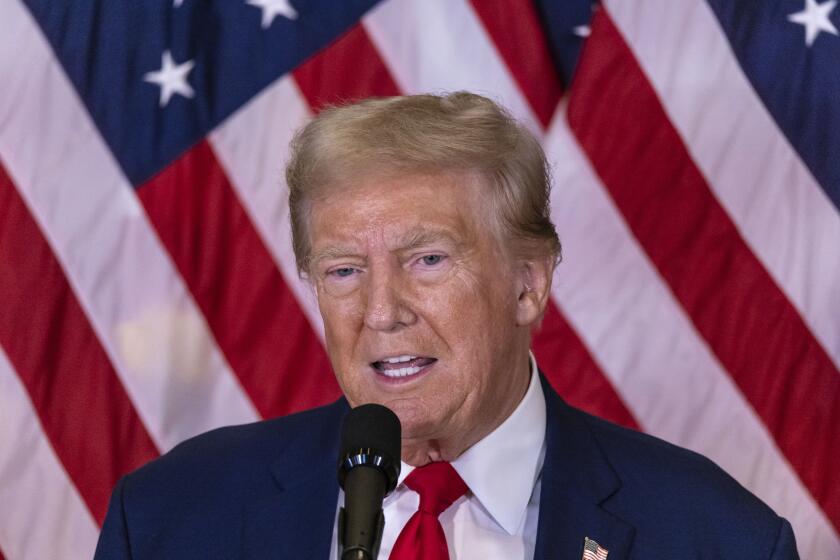New stadium design: ‘Essence of San Diego’
Architect outlines details: New fan experience, Super Bowl-ready features
- Share via
A new design for the Chargers stadium represents the "essence of San Diego," with varied landscapes, vistas to the surroundings, new fan features that promote outdoor living and a "kinetic skin" that mimics the sound of the ocean.
Scott Radecic, a senior principal at the Kansas City-based Populous architecture firm, said the city commissioned a design six weeks ago for a 68,000-seat stadium at the Qualcomm Stadium site in Mission Valley. He said designers sought to capture many elements of San Diego's natural landscape and climate.
"We wanted to make sure as a team that we were making this a really authentic place and people who see it will say, 'That represents our city -- that represents where the Chargers should be. They've been here over 50 years and they should stay here.' This stadium represents that. This is an expression of San Diego."
At the same time, Radecic said his architects strove to make the stadium Super Bowl ready.
"This will be the best stadium for NFL Super Bowls," he said. "It's been designed (that way) from the very beginning."
Populous is well acquainted with San Diego. It designed the Chargers' first concept for the Mission Valley site in 2003; their 2010 concept downtown; and last year's proposal for a combination stadium-convention center. It also designed Petco Park along with world-renowned architect Antoine Predock. Radecic has a personal connection to San Diego as well, since his son Matt works at Qualcomm Corp. and lives in Del Sur in the state Route 56 corridor.
View the photo gallery: Chargers stadium design - August 2015
The team's first task was to pick the best site where a new stadium could be built while leaving Qualcomm Stadium in place until the 2019 season. The old stadium would then be demolished. The northeast corner of the 166-acre property was picked because its naturally sloping terrain would make it possible to build without a great deal of cut-and-fill excavation.
The next decision was to open break up the seating bowl so people inside could see out and outsiders could see in.
"The idea was not to have a stadium that is focused on one thing but on multiple things," Radecic said.
That design goal meshed with the idea of making it easy for people to move about the stadium on bridges and through common spaces and not lose sight of the field.
What do you think of the new design for the Chargers stadium?
Love it 67% (1598)
Hate it 33% (784)
2382 total votes.
"There were a lot of things that influenced the design on the stadium," Radecic said. "One is San Diego and its interconnected villages. When people talk about San Diego they say I live in La Jolla or Del Mar, Hillcrest, Point Loma, and that aspect of San Diego we found very striking and interesting along with a lot of the natural terrain."
He said the river valleys, chaparral, beaches and colorful gardens of Balboa Park inspired a landscaping plan reflecting these four different environments. One rendering shows hanging gardens reaching from one level to another.
The ocean is referenced in a "kinetic skin" of metal plates hinged at the top that flutter when the wind blows.
"The ocean makes San Diego a unique place in the U.S. and how can we bring that element in to the building?" he said the team asked itself. "We've done that through the use of the kinetic skin."
He said the materials would weather naturally and not turn into a "maintenance nightmare."
San Diego's benign climate also was cited as a reason include sun shades but not a retractable roof.
"There isn't a better place in the country than San Diego to sit outside and watch a football game," he said.
But stadium designs and consumer preferences have changed since Qualcomm Stadium opened in 1967.
"The NFL has created a fantastic game to watch on TV, so it has seen some declining attendance across the league," he said. "The key to today's stadium is to incorporate many more fan-friendly environments into the building so people do want to come to the games."
Among the features proposed in the new design:
- Fan Park: A place where kids can skateboard, throw the ball and get exercise before the game.
- Corporate hospitality: This area near the entrance on the west side of the building would be a permanent place for companies to entertain guests and for civic events.
- VIP Atrium: Most people would enter the stadium at the mezzanine level and go up or down 20 feet to various levels via steps, escalators and elevators. The VIP Atrium level would offer an indoor and outdoor clubhouse.
- Sideline Club and endzone suites: These areas would be places fans could go to during the game to watch the action at ground level.
- A Hall of Fame is depicted in one rendering as one of many attractions for visitors to enjoy on nongame days.
- Landscaped promenades: Instead of the present asphalt parking lot, tree-lined avenues would lead into the stadium and orient visitors to the various entrances. The design does not depict possible redevelopment of the parking lot in future years as was suggested most recently by a mayoral stadium task force.
- Stadium-trolley connection: A more people-friendly trolley station would reduce congestion for fans arriving by mass transit and lead people to and from the stadium in an efficient, pleasant arrangement.
- Super Bowl features: There would be two home-team-sized locker rooms and four tunnels leading to the field to make halftime entertainment easy to set up and tear down. A diagram in the firm's design presentation depicts where Super Bowl activities would take place.
Beyond NFL use, Radecic said the new stadium would be an ideal venue for World Cup and Olympic soccer matches, rugby tournaments and major concerts. It has not been designed for track and field events but those could be accommodated if necessary.
Radecic said the design was approached with the $1.1 billion project cap in mind.
"Given the cost of recent stadiums and San Diego-area construction costs, we feel that the budget is appropriate to be able to do the things the city would like to do in the stadium," he said. "We're confident in the budget right now."
Suscríbase al Kiosco Digital
Encuentre noticias sobre su comunidad, entretenimiento, eventos locales y todo lo que desea saber del mundo del deporte y de sus equipos preferidos.
Ocasionalmente, puede recibir contenido promocional del Los Angeles Times en Español.




